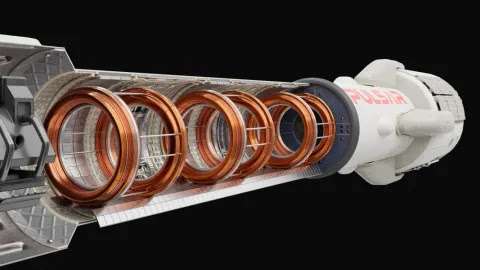
A Fusion Rocket Designed to Travel 500,000 mph Is Under Construction
In a leap toward the future of space exploration, scientists and engineers are making strides in the development of a revolutionary propulsion system: a fusion rocket capable of reaching speeds of up to 500,000 miles per hour. This ambitious project represents a significant advancement in propulsion technology, with the potential to revolutionize interplanetary travel and open new frontiers in our exploration of the cosmos.
At the forefront of this endeavor is a team of researchers from leading aerospace companies and academic institutions, working in collaboration to design and construct the world’s first practical fusion rocket. Unlike conventional chemical rockets that rely on the combustion of propellant, fusion rockets harness the power of nuclear fusion—the same process that fuels the sun—to generate thrust and propel spacecraft through the vacuum of space.
The key to the fusion rocket’s extraordinary speed lies in its ability to achieve and sustain controlled nuclear fusion reactions within its engine. By fusing together isotopes of hydrogen—such as deuterium and tritium—at temperatures exceeding millions of degrees Celsius, the rocket generates immense amounts of energy that can be converted into thrust through a process known as magnetic confinement.
The fusion rocket’s design incorporates advanced magnetic coils and containment systems to confine and control the fusion reactions, allowing for sustained propulsion over long distances. With its unparalleled efficiency and power, the fusion rocket promises to dramatically reduce travel times between planets and enable faster, more cost-effective exploration of the solar system and beyond.
One of the most exciting prospects of the fusion rocket is its potential to enable crewed missions to distant destinations, such as Mars and beyond. With conventional chemical rockets, interplanetary journeys can take months or even years, exposing astronauts to prolonged periods of radiation and microgravity. In contrast, the high speeds achievable by the fusion rocket would significantly shorten travel times and reduce the risks associated with long-duration spaceflight.
Moreover, the fusion rocket’s versatility and efficiency make it well-suited for a variety of mission profiles, from robotic probes and cargo transport to crewed missions and beyond. Its ability to generate thrust continuously without the need for large quantities of propellant could revolutionize space logistics and enable ambitious missions that were previously unthinkable.
While the development of the fusion rocket is still in its early stages, preliminary tests and simulations have shown promising results, demonstrating the feasibility of achieving sustained fusion reactions and generating thrust. As researchers continue to refine and optimize the technology, the prospect of a fusion-powered future in space grows ever closer.
The construction of a fusion rocket represents a bold step forward in humanity’s quest to explore and colonize the cosmos. With its potential to unlock the vast reaches of space and propel us toward distant worlds at unprecedented speeds, the fusion rocket stands as a beacon of innovation and ambition, ushering in a new era of space exploration limited only by the bounds of our imagination.
Reference: freethink

Very interesting article.